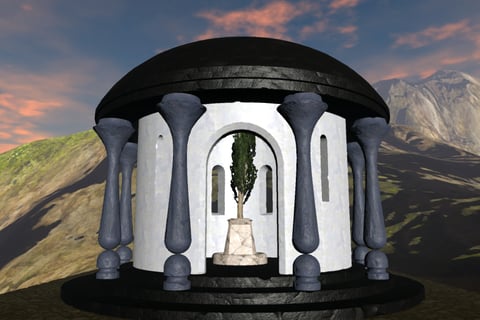Tempio di Cipressi
A VRChat world
1/12/20242 min read
A few months ago I set a goal to create a VRChat world by the end of 2023. Not as something groundbreaking or even polished, but as the beginning of an exploration into the tools and techniques needed both to create more refined works and better understand those of others. And of course, months passed without doing much about it. So I told a few friends I would have a world out by the end of the year, which more or less obligated me to make sure it happened, and so with very limited prior knowledge of Unity, and a few long days over about three weeks, I did manage to meet that objective. It isn’t complete, and may very well never be, but it does exist, and this is meant as a brief explanation of what it is about, for those who are curious.
The world developed more or less organically from a single idea, and that was wanting to somehow incorporate the Babylonian Royal Game of Ur into a floorplan. That was the basis for the courtyards, and the idea of the main temple complex itself as a container for life and progress through it. The conjectural entrance and exit to the board (as we do not know for certain) became the small rooms dividing the East and West courtyards. The colour scheme of black, white, and reddish stone recalls the building complexes of Mycenean Crete, another of the cultures from which inspiration was drawn.
There is a fair amount of symbolism present, consistent with beliefs from numerous cultures and periods but not necessarily shared between one another. These are mostly used solely as inspiration and not meant to be pretentious, or even particularly serious! In building a sense of place it is useful to have guiding principles, and it is these that drove the overall design. The cypress trees which give the temple its name (Temple of the Cypresses), for example, are markers of life and death, immortality and the underworld, and as such are a common feature of cemeteries. Here I wanted to focus on beginnings rather than endings, and the transformative and transitory nature between. The East-West orientation of the temple complex aligns it and the starstone on the nearby ridge with, at certain times, the passage of the sun. That sunlight is then channeled through the complex to the temple doorway, providing the unifying energy necessary for life and growth. In this case, I have ascribed a tripartite mythology to this process, wherein a binary male/female union combine into a third being encapsulating all and none of the other two.
Aelithra is the female aspect, she is The Ascendant, the Bearer of All, The First. Her door is in the North Wall, descending to her home in the Earth.
Zephyrian is the male aspect, he is The Wanderer, Forager, and Enforcer. His door is on the South Wall, and leads into the open fields and his home in the hills.
Morphara (originally Morphonos) is both the neuter and hermaphroditic aspect, able to take on both male and female aspects, or neither. They are The Unifier and flow amongst the waters.
Following this, within the niches of North and South walls are busts of the priestesses and priests who have served Aelithra and Zephyrian, respectively. Likewise, the sacred cypresses dwell in pairs, with those in the South planter being taller and more slender than their "female" counterparts. The most sacred cypress is in the rotunda and combines two into one, representing Morphara. Supplicants are encouraged to bring water from the courtyard to their basin as offering.
The starstone also embodies these aspects, having three sides, with a hard, pointed “male” exterior combined with an obvious “female” interior, but formed together. Tripartite symbolism continues in the rows of the courtyard, the final steps of the temple and starstone, the three sets of three balusters in the railing of the loggia, itself formed of three barrel vaults, and the columns and windows of the rotunda which are multiples of three.


